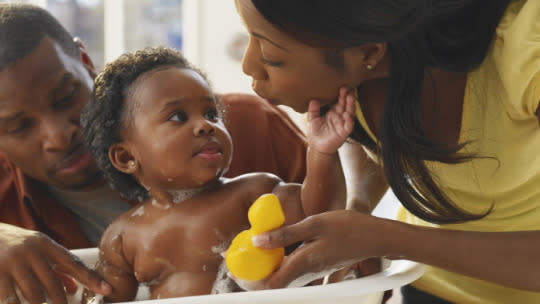7 Baby Bathing Tips No Parent Can Afford to Ignore

When you are a first-time parent, every day is new experience. It is normal to feel overwhelmed or intimidated as you learn to care for your child. Newborns seem especially fragile and there are safety concerns every parents should consider, so it isn’t uncommon to feel like bathing a brand-new baby is an anxiety-ridden experience.
Understanding how to bathe a baby safely is important — accidental drowning is responsible for 30 percent of unintentional deaths in children under the age of 4. Still, parents don’t need to feel fearful when they bathe their children. Instead, through proper education, parents can use safe bathing practices and ease their anxiety, knowing they are doing everything necessary to protect their babies during bath time.
More: Mom shares ‘secret formula’ for getting babies to sleep through the night
While most moms get a quick lesson on baby bathing from a labor and delivery nurse before discharge, sleeplessness, information overload or the beautiful distraction of a new baby can make it difficult to remember everything taught during your hospital stay. Stephanie Levine, DO, FAAP, is a board-certified general pediatric physician and the pediatrician representing the nonprofit organization Keeping Babies Safe. She shared this advice for keeping your baby safe while giving them a bath.
1. Wait to give the first bath
Until the stump of your baby’s umbilical cord has fallen off, which could take anywhere from two weeks to two months, wait to give them their first bath. The area surrounding the umbilical cord should be kept clean and dry to avoid infection. Newborns don’t really get dirty, and can be wiped off with a washcloth and a gentle soap during the first several weeks of life.
2. Until Baby can sit unassisted, use a baby bathtub
During the first several months of their lives, a baby bath with a non-skid mat underneath is the safest and easiest way to bathe a newborn. Fill the bath with a few inches of warm water and add a little baby wash. Most babies will not be able to sit unassisted until between month four and month eight, and the baby bath allows parents to safely recline their baby without worry about the baby slipping. Once your child is sitting unassisted, you can transition your baby to a full-sized tub.
3. Never leave a baby or toddler alone in a bath
It only takes moments for a baby to slip into the water, and having a baby within eyesight is not enough to protect them from drowning. Always keep one hand on your baby at all times and never step away from a baby or toddler who is in a bathtub, even if you are simply stepping away to grab a towel or soap. To avoid the need for stepping away, gather everything before running the water — a washcloth, baby soap and a towel is all you need. If you forget something essential to the bath, ask your partner to bring it to you or pick up your baby and bring them along. Avoid distraction during the bath by leaving your cell phone in another room.
More: 8 Things no one tells you pregnancy will do to your vagina
4. Keep baby warm and moisturized
As soon as the water in the bath begins to cool, remove the baby and wrap them securely in a towel to prevent loss of body heat. Before dressing your baby, dry them off completely and use a moisturizer created for sensitive skin to keep Baby’s skin hydrated.
5. Empty the bathtub right away
To avoid accidental drowning of a mobile baby or toddler, always empty the bathtub immediately after removing your child from the tub. Even when you keep a close eye on your child, it only takes a few moments of distraction for them to wander into the bathroom, and leaving a bathtub filled with water could be putting their life in danger.
More: 5 Natural tips to boost milk supply when you’re breastfeeding
6. Baby-proof the tub and the bathroom
Parents should baby-proof the bathroom just as they would any other room in the house. Secure cabinets filled with toiletries and keep medicine in a locked cabinet out of reach. To avoid injury while in the tub, place a non-slip mat in the bottom of the tub, cover the water spout and set the water heater at 120 degrees Fahrenheit. As the child grows older, only introduce toys that are age-appropriate and specifically designed for use in the bathtub.
More: Baby names from classic books for your future bookworm
7. Enroll all caregivers in a CPR class
Prevention is the primary means of protecting a child from injury or drowning while bathing, but it is crucial to be prepared in the case of an emergency. Anyone who cares for your child — parents, grandparents and caregivers — should be enrolled in a CPR class. To find a CPR class in your area, visit the American Heart Association online. —Mary Sauer
(Photo: Getty Images)
